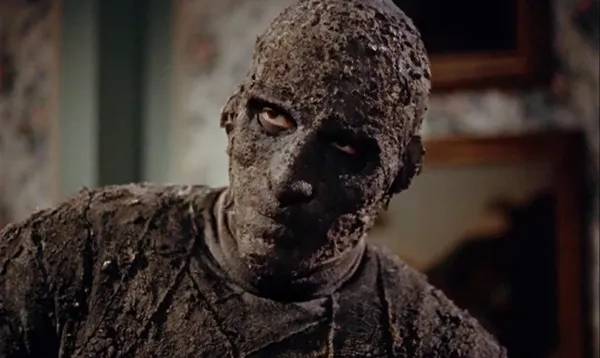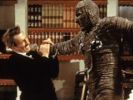Eye For Film >> Movies >> The Mummy (1959) Film Review

A lot of harm could be averted in horror films if only parents and teachers did a better job of teaching people to read silently, without moving their lips.
Made in the wake of The Curse Of Frankenstein and Dracula, when Hammer was the hot new thing and genuinely terrifying audiences, The Mummy also came along at a point when British attitudes to Egyptology – and specifically the pilfering of tombs – were on the cusp of change. It begins when a group of pith-helmeted archaeologists enter a tomb in defiance of warnings about a curse, to steal the sarcophagus of the beautiful Princess Ananka, once Karnak’s high priestess. The mission is, superficially, a success, but reading aloud the Scroll of Life inadvertently leads to the resurrection of her male counterpart (played by a bandage-swaddled Christopher Lee), who is subsequently smuggled to England by devotee Mehemet Bey (George Pastell) to wreak a terrible revenge on the defilers.

As in Hammer’s previous hits, the film places a monstrous (yet not wholly unsympathetic) Lee in opposition to an intellectual (but not entirely innocent) Peter Cushing. Here, Cushing plays John Banning, the only member of the expedition who did not enter the tomb (on account of a broken leg), who is called upon by his ailing father to put an end to the monster’s rampage. At first he dismisses the whole thing as nonsense, but a close encounter teaches him otherwise, especially when a bullet fired at close range has no effect.
Before George Romero reinvented zombies, before The Terminator, the Mummy was really the very first seemingly unstoppable monster, striking fear into viewers in much the same way. Like many similar creatures, it paid for this power, and for its tremendous strength, by having low intelligence, but not with an absence of sensitivity. Communicating only through heavily restricted movements and his eyes, Lee gives a remarkable performance, bringing humanity to this unfortunate being. Though at first the Mummy acts purely at Mehement’s command, all bets are off after he catches sight of John’s wife, the beautiful Isobel (Yvonne Furneaux, at that time the darling of the European arthouse scene), immediately recognising her as the reincarnation of his secret love, the Princess Ananka herself.
It’s really Lee’s performance which gives the film its soul. Furneaux is woefully underused. There are no weak links in the cast, however, with a wealth of great supporting turns from actors who would go on to become Hammer regulars. Though his character is positioned as a villain, Pastell also deserves notice for pointing up the moral ambiguities of the story. It’s easy to see Mehemet’s sincere belief that what he is doing is just, and the film contributed to a gradually developing awareness that grave robbing – no matter how pretty the artefacts recovered, or in whose name they were originally interred – might be out of line.
With a grand, operatic score and a great deal of money (for the time) poured into production design, The Mummy is one of the most spectacular films Hammer ever made, and is a must-see for fans. It’s worth remembering that a lot of films at the time were still being made in black and white, so its vivid use of colour really made an impact, and viewers were getting a glimpse of a world which they had read about in pulp novels but – with Cleopatra still four years away – had never seen rendered in this way before. It still has a lot of atmosphere and, whilst fascinating as a piece of film history, remains an enjoyable watch.
Reviewed on: 29 Aug 2022















